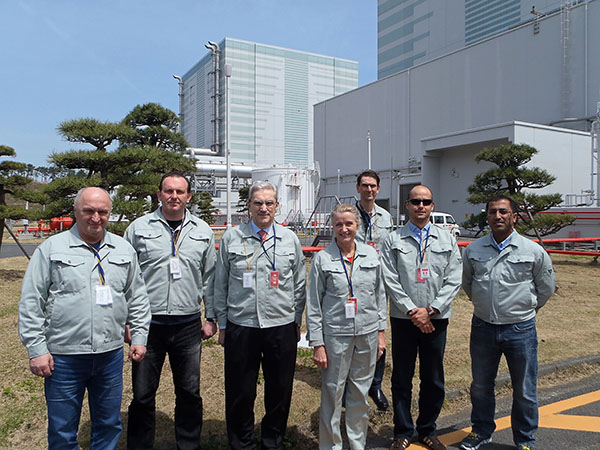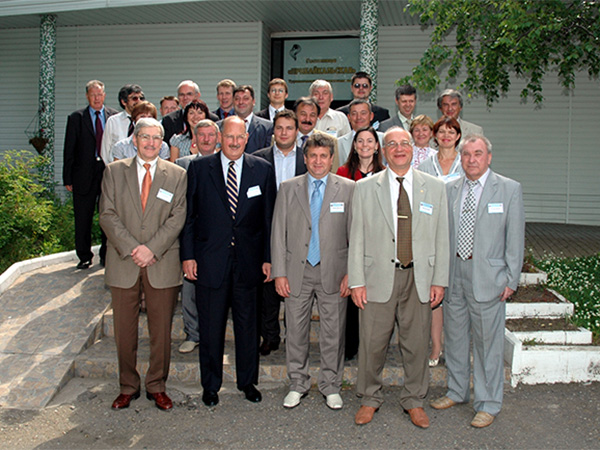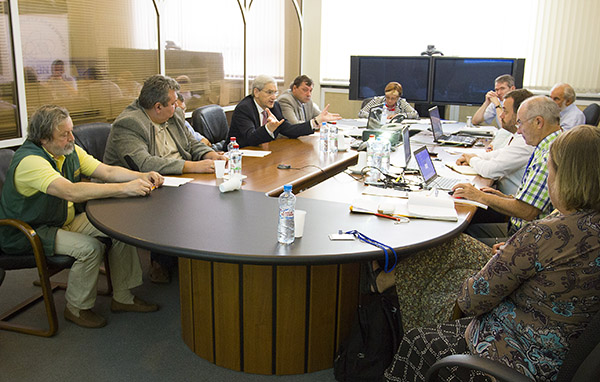| Ðóññêèé / English |
|

|
NUCLEAR SAFETY INSTITUTE OF THE
RUSSIAN ACADEMY OF SCIENCES
|
INTERNATIONAL COOPERATION

The quarter-century history of the Institute is marked by fruitful scientific cooperation with many international organizations such as: International Atomic Energy Agency (IAEA), Nuclear Energy Agency of Organization for Economic Cooperation and Development (NEA/OECD), Commission of the European Communities (CEC), International Science and Technology Center (ISTC), Committee on Safety of Nuclear Installations (CSNI), World Nuclear Association (WNA), Northern Dimension Environmental Partnership (NDEP), European Bank for Reconstruction and Development (EBRD), and many others. IBRAE as a highly skilled expert organization is involved in several intergovernmental agreements and international programs through a partnership with governmental and commercial institutions of the USA, Germany, France, the Nordic countries and others.
The areas of IBRAE RAN international cooperation:
- safety analysis of NPP reactor installations including new generation fast reactors;
- radioactive materials and waste management;
- environmental safety;
- radiation monitoring and emergency response;
- reducing the threat of radiological terrorism;
- enhancing the skill of nuclear industry specialists; and
- nuclear activity regulations.
Cooperation in the Nuclear Safety Area
Participation in joint research projects with foreign partners that address a variety of NPP safety-related issues has been and still remains the main focus of international activities of the Institute.
The most significant of these projects are the following:
- RASPLAV-MASKA Project established by NEA/OECD;
- ISTC-PARAMETER Project (supported by the International Science and Technology Center);
- ERCOSAM-SAMARA parallel running projects (under Rosatom – Euratom cooperation);
- International Collaborative Standard Problem (ICSP) MASLWR under the IAEA aegis;
- ATMI-2 benchmark conducted by the WGAMA OECD working group;
- OECD-NEA benchmark study of the accident at the Fukushima Daiichi Nuclear Power Plant (BSAF) project (under the NEA/OECD auspices); and
- HYMERES NEA/OECD Project focused on ensuring the integrated safety during severe accidents with hydrogen release to NPP containment.
Through these and other projects, verification and cross-verification of IBRAE developed physical and computational models as well as severe-accident and fuel codes for thermal water-cooled reactors and advanced fast reactors with liquid metal coolant against the experimental data are carried out.
Teaching and methodological training of specialists of abroad supervisory authorities in the countries importing Russian nuclear technologies (Bulgaria, Hungary, India, Iraq, China, Slovakia, Ukraine, Finland, etc.) is another important area of IBRAE international cooperation. The implementation of joint (with the State Corporation ‘Rosatom’) training programs is conducted by the IBRAE staff using software, information and methodological base of the Institute including computer simulators and integrated computer codes developed at IBRAE RAN.
Cooperation on Radiation Monitoring and Emergency Response
Participation in the development and implementation of international projects for enhancement of radiation monitoring and emergency response in the Murmansk and Arkhangelsk Regions during 2005-2012 became an important achievement of IBRAE. The projects implemented under the G8 Global Partnership Initiative and the MNEPR (Multilateral Nuclear Environmental Program in the Russian Federation) Agreement were financed by the NDEP Support Fund administered by the European Bank for Reconstruction and Development (EBRD). IBRAE coordinated the work and provided scientific & technical support to the projects which were highly appraised by the IAEA mission, whereas the regional radiation monitoring and emergency response systems established as the outcome of the Projects implementation were recommended as models for establishing similar systems in other regions of Russia.
IBRAE collaborates closely with leading international organizations and scientific & technical centres on development of hardware and software for radiation monitoring and emergency response including computer codes for predicting the radiation situation in the ‘near’ and ‘far’ zones around Nuclear- and Radiation-Hazardous Facilities (NRHF) and simulating radionuclide migration in air, water and in urban areas (NOSTRADAMUS, NEPTUNE, CASSANDRA, etc.). In particular, using these software specialists of IBRAE Technical Crisis Centre (TCC) made a real-time forecast for the development of the radiation situation and the risks to the public caused by the Fukushima Daiichi NPP accident of 11.03.2011, which was transferred to the Japanese side already on 13.03.2011.
Implementation of educational programs to improve operational preparedness and training of emergency response officers and the staff of facility- and regional-level radiation monitoring systems along with the preparation and conduct of comprehensive exercises and drills with the participation of foreign partners and observers is another area of IBRAE international cooperation. One of the first exercises ‘Becquerel-1996’ – was developed and conducted in cooperation with IRSN (France). Since the middle of last decade, major international exercises organised by IBRAE are held annually. Within the framework of software & hardware support of crisis centres and in collaboration with the U.S. Department of Energy (DOE) IBRAE is developing computer simulators for training personnel of crisis centres. Jointly with the U.S. DOE and the State Corporation ‘Rosatom’, the Institute participated in the projects for establishing ‘Emergency Response’ Training Centre at the Rosatom Moscow Institute for Advanced Studies (MIPK ‘Atomenergo’) and Rosatom Emergency Technical Centre in St. Petersburg.


In recent years, special attention of the international community has been given to the problem of combating the threat of radiological terrorism. IBRAE in cooperation with IAEA and the U.S. National Academy of Sciences (NAS) takes an active part in solution of this problem both in terms of bringing the national legal & regulatory framework in the radiation safety area in line with international standards, and in terms of developing new generation software to simulate the radiation situation in the urban environment with complex infrastructure.
Cooperation to Ensure Nuclear, Radiation and Environmental Safety of the Russian Nuclear Fleet Facilities
Under this research area, IBRAE participates in the preparation and conduct of international research expeditions (IASAP, ‘The Kara Sea’ and other projects) to study the radio-ecological situation in the Arctic and Northwest Russia in the regions of solid radwaste dumping and damaged nuclear submarine sinking. Also, IBRAE acts as a coordinator of several international projects for radiation monitoring in these regions.
The development and endorsement of Strategic Master Plan (SMP) for Decommissioning of Retired Nuclear Fleet and Environmental Rehabilitation of Its Supporting Infrastructure in Northwest Russia has been the most important result of many international efforts in this field. The SMP Development Team was headed by Prof. L.A.Bolshov, the IBRAE Director, whereas the general scientific supervision was executed by Acad. A.A. Sarkisov, adviser of the Russian Academy of Sciences. The involvement of the so-called ‘International Consultant’ (experts of Fluor Ltd and BNG PS) became a new element in development of such large-scale programs.
Working on the SMP is an unprecedented example of large-scale cooperation and coordination of efforts between donor countries, the RF federal and regional public authorities, many ministries, agencies and project-executing organizations to address the global challenge — providing full and safe disposal of the Cold War nuclear legacy and environmental rehabilitation of the region. The SMP was developed under the Global Partnership and MNEPR Agreement with financial support from the NDEP Support Fund and with participation of the UK, Germany, Italy, Norway, Sweden, Finland and other countries. Currently, the implementation of the SMP projects and programs continues successfully under IBRAE scientific and technical support.
Leading scientists and specialists of the Institute participate in workshops and plenary meetings of the IAEA Contact Expert Group (CEG), which activities are focused on topical issues of international cooperation in the radiation safety and radioecology areas. In autumn of 2011, the Jubilee 25th CEG Plenary Meeting was held, where the prospects for international cooperation on ensuring the safety of the Arctic and Pacific Oceans after the completion of the Global Partnership in 2012 were discussed, and a recommendation was formulated to start a new SMP for the Arctic region and Far-East Russia.
Cooperation in the Environment Protection Area
The development of procedures for safe management and final disposal of radioactive waste is one of the most topical areas of cooperation in the environment protection area. IBRAE conducts basic and applied research on the development of mathematical tools and designing computer codes on this basis to simulate radionuclide migrations in various geological media including heterogeneous ones. The developed mathematical models are validated by simulation of the results of international field experiments (MADE, etc.) and through participation in international research programs (ASCEM, etc.).
The development of integrated programs for elimination of radio-ecological and socio-economic implications of radiation accidents is another important area of IBRAE international cooperation. In particular, the Institute was involved in the ‘Radioecology’ project under the French-German initiative to assess the consequences of the Chernobyl accident.
In partnership with ‘Rosatom’ State Corporation, the EMERCOM of Russia, the National Academy of Sciences and Ministry of Emergency Situations of the Republic of Belarus, IBRAE is one of the coordinators of the Russian-Belarusian joint program of activities on overcoming the consequences of the Chernobyl accident within the framework of the Union State of Russia and Belarus and provides information and expert support of its activities. The Russian-Belarusian Information Centre was established on the IBRAE technical basis, and the IBRAE specialists took part in its activity.
Bilateral and Multilateral Agreements
International activities of IBRAE are carried out on the basis of bilateral or multilateral treaties and agreements on cooperation with various international and national organizations. The most significant of these agreements are:
International Agreements and Programs
- The Agreement on the Multilateral Nuclear Environmental Programme in the Russian Federation (MNEPR);
- Agreement between the Government of the Russian Federation and the Government of the United States of America on cooperation in research on radiation effects to the purpose of minimizing the consequences of radioactive contamination on health and the environment
- The Agreement between the Government of the United States of America and the Government of the Russian Federation for Cooperation in the Field of Peaceful Uses of Nuclear Energy (the U.S.-Russia 123 Agreement);
- The Agreement between the Government of the Russian Federation and the Government of the Italian Republic Concerning Cooperation in the Area of Dismantlement of Russian Nuclear Submarines Withdrawn from the Navy and Safe Management of Radioactive Waste and Spent Nuclear Fuel;
- The Seventh Framework Programme of the European Atomic Energy Community (Euratom);
- The United Nations Development Programme (UNDP) in the Russian Federation;
- The Arctic Military Environmental Cooperation (AMEC) Program.
Key Partners of IBRAE RAN and Bilateral Agreements
The U.S. Department of Energy (DOE)
- The Project Arrangement between the Department of Energy (DoE) of the United States of America and the Nuclear Safety Institute (IBRAE) of the Russian Federation for Coordination of Emergency Preparedness and Response Activities;
- The U.S. Argonne National Laboratory (ANL) – the cooperation is carried out within the Agreement between the Government of the United States of America and the Government of the Russian Federation for Cooperation in the Field of Peaceful Uses of Nuclear Energy (the U.S.-Russia 123 Agreement);
- The U.S. Idaho National Laboratory (INL) – the cooperation is carried out within the Agreement between the Government of the United States of America and the Government of the Russian Federation for Cooperation in the Field of Peaceful Uses of Nuclear Energy (the U.S.-Russia 123 Agreement);
- The U.S. Oak Ridge National Laboratory (ORNL) - the cooperation is carried out within the Agreement between the Government of the United States of America and the Government of the Russian Federation for Cooperation in the Field of Peaceful Uses of Nuclear Energy (the U.S.-Russia 123 Agreement) and within the U.S. ASCEM (Advanced Simulation Capabilities for Environmental Management) Program;
- The U.S. Brookhaven National Laboratory (BNL) – cooperation in the field of reducing the threat of radiological terrorism and limiting unauthorized access to sources of ionizing radiation;
- The U.S. Savannah River National Laboratory (SRNL) – a joint research project within the ASCEM (Advanced Simulation Capabilities for Environmental Management) Program on transport of contamination in geological media.
The U.S. Nuclear Regulatory Commission (NRC)
- The Agreement between the NRC and the Institute of Nuclear Safety (IBRAE) of the Russian Academy of Sciences on the Development and Application of Nuclear Safety Analysis Codes and Probabilistic Risk Assessment Techniques.
The U.S. National Academy of Sciences (NAS)
- The partnership is based on cooperation agreements in scientific, engineering and medical research. Within its framework, joint investigations on counteracting radiological terrorism and non-proliferation of nuclear technology and materials were conducted.
Institut de Radioprotection et de Sûreté Nucléaire (IRSN), France
- The Agreement between IBRAE and IRSN on cooperation in the field of nuclear safety and radiation protection;
- The Agreement on the coordination between the ERCOSAM Project and the SAMARA Project.
Commissariat à l’Energie Atomique et aux Energies Alternatives (ÑÅÀ), France
- The cooperation is based on the agreement between the ‘Rosatom’ State Corporation and the CEA on cooperation in the use of nuclear power for peaceful purposes;
- The Agreement on the Coordination between the ERCOSAM Project and the SAMARA Project;
- The Agreement on the OECD/NEA HYMERES Project.


Gesellschaft fur Anlagen und Reaktorsicherheit (GRS), Germany
- Cooperation Agreement in the field of nuclear energy research;
- The Agreement on the OECD/NEA HYMERES Project.
Paul Scherrer Institut (PSI), Switzerland
- Memorandum of Understanding in the field of nuclear energy research;
- The Agreement on the Coordination between the ERCOSAM Project and the SAMARA Project;
- The Agreement on the OECD/NEA HYMERES Project.
Nuclear Research & Consultancy Group (NRG), the Netherlands
- The Agreement on the Coordination between the ERCOSAM Project and the SAMARA Project.
Karlsruhe Institute of Technology (KIT), Germany
- Cooperation Agreement in the field of nuclear energy research;
- The Agreement on the coordination between the ERCOSAM Project and the SAMARA Project.
Atomic Energy of Canada Limited, Canada
- The Agreement on the coordination between the ERCOSAM Project and the SAMARA Project.
- The Agreement on the OECD/NEA HYMERES Project.
Swedish Radiation Safety Authority - SSM, SKB è SKB International, Sweden
- Co-operation agreement between SKB IC and IBRAE concerning disposal of radioactive waste.
Ministry of Emergency Situations of the Republic of Belarus
- The Cooperation is based on the Russian-Belarusian joint program of activities on overcoming the consequences of the Chernobyl accident within the framework of the Union State of Russia and Belarus.
 |
IBRAE RAN © 2013-2025 | Site map | Feedback |